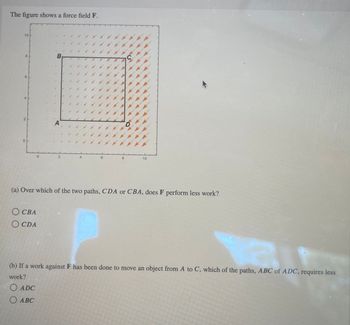Question

Transcribed Image Text:The figure shows a force field F.
10
2
0
0
B
OCBA
OCDA
A
6
D
10
(a) Over which of the two paths, CDA or CBA, does F perform less work?
(b) If a work against F has been done to move an object from A to C, which of the paths, ABC of ADC, requires less
work?
O ADC
O ABC
Expert Solution
This question has been solved!
Explore an expertly crafted, step-by-step solution for a thorough understanding of key concepts.
Step by stepSolved in 4 steps with 5 images

Knowledge Booster
Similar questions
- A positive charge is being pushed by a 5.65 N/C field with a force of 65.32 N. What is the value of the charge (in C)?arrow_forwardSee figure. All charges are positive except q3. What is the initial acceleration of q4, which has a mass of 6.50 micrograms? Recall that acceleration is a vector and should be expressed accordingly.arrow_forwarde- enters 2.4 × 10−6 N/C field, point right. find magnitude and direction of accelerationarrow_forward
- A positive charge is being pushed by a 9.48 N/C field with a force of 15.63 N. What is the value of the charge (in C)?arrow_forwardL vo y E A uniform field E = -150000j N/C exists between two plates of length L = 3 cm, as shown in the figure above. A proton is fired at an angle of 40° to the x axis with an initial speed of 7300000 m/s. a) Find its vertical coordinates as it emerges from the plate, assuming the proton will not hit any plate in the process. cm b) Find the angle at which it emerges. degrees to the x axis.arrow_forwardAn electron travels from right to left at 3 x 10° m/s when it encounters the B field pictured below. The magnitude of the field is 1Tesla. Draw a picture of the electron's path in the field with the correct direction. Calculate the radius of curvature. х хarrow_forward
- What is the magnitude of an electric field at a point that is 4.24 meters away from a 1.95C charge?arrow_forwardElectric fields exert a force on a charged particle, which makes it want to move. True/false Insulators are a category of material in which charges may freely move. True/Falsearrow_forwardGive an example of a nonconstant field with zero divergence. Give an example of a field with a constant negative divergence.arrow_forward
arrow_back_ios
arrow_forward_ios